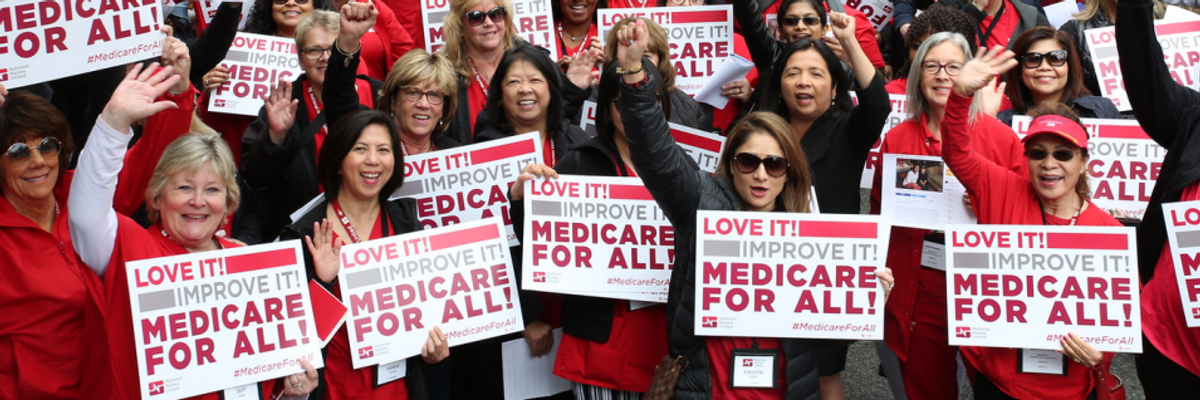
A comprehensive policy solution would be to extend Medicare and Medicaid to all those suffering job losses during the pandemic period, with the federal government funding this expansion.(Photo: NNU/flickr/cc)
12.7 Million Workers Have Likely Lost Employer-Provided Health Insurance Since the Coronavirus Shock Began
The linkage between specific jobs and the availability of health insurance is a prime source of inefficiency and inequity in the U.S. health system.
Since the economic fallout of the coronavirus shock began in early March, the number of workers laid-off or furloughed--as measured by new claims for unemployment insurance (UI)--has skyrocketed. We have used data from states that track UI claims by industry to get a rough estimate of how many workers are at high risk of losing their employer-provided health insurance (EPHI) over this as well.
The methodology is described in this blog post, and the underlying data (which has begun to include more and more states tracking UI claims by industry) can be found here. Table 1 below shows UI claims by industry across states that collect this data, and also shows employer-provided health insurance (EPHI) coverage rates in those industries in 2018. As of April 30, just under 28 million workers had been laid off or furloughed since early March. We find that this translates into likely EPHI losses of 12.7 million.
Because the United States is unique among rich countries in tying health insurance benefits to employment, many of the newly unemployed will suddenly face prohibitively costly insurance options. A comprehensive policy solution would be to extend Medicare and Medicaid to all those suffering job losses during the pandemic period, with the federal government funding this expansion. It has been proposed that the federal government pay for all of COBRA coverage so that workers who are laid off or furloughed may continue their employer-provided coverage. While this policy proposal will help many workers continue coverage, in some states it will not help workers from small businesses with fewer than 20 employees, who are not eligible for COBRA.
The linkage between specific jobs and the availability of health insurance is a prime source of inefficiency and inequity in the U.S. health system. It is especially terrifying for workers to lose their health insurance as a result of, and during, an ongoing pandemic.
We additionally allocate EPHI losses across states, taking account of each states' industry mix (again, the precise methodology for this calculation can be found here). The map below shows these losses allocated across states.
An Urgent Message From Our Co-Founder
Dear Common Dreams reader, The U.S. is on a fast track to authoritarianism like nothing I've ever seen. Meanwhile, corporate news outlets are utterly capitulating to Trump, twisting their coverage to avoid drawing his ire while lining up to stuff cash in his pockets. That's why I believe that Common Dreams is doing the best and most consequential reporting that we've ever done. Our small but mighty team is a progressive reporting powerhouse, covering the news every day that the corporate media never will. Our mission has always been simple: To inform. To inspire. And to ignite change for the common good. Now here's the key piece that I want all our readers to understand: None of this would be possible without your financial support. That's not just some fundraising cliche. It's the absolute and literal truth. We don't accept corporate advertising and never will. We don't have a paywall because we don't think people should be blocked from critical news based on their ability to pay. Everything we do is funded by the donations of readers like you. Will you donate now to help power the nonprofit, independent reporting of Common Dreams? Thank you for being a vital member of our community. Together, we can keep independent journalism alive when it’s needed most. - Craig Brown, Co-founder |
Since the economic fallout of the coronavirus shock began in early March, the number of workers laid-off or furloughed--as measured by new claims for unemployment insurance (UI)--has skyrocketed. We have used data from states that track UI claims by industry to get a rough estimate of how many workers are at high risk of losing their employer-provided health insurance (EPHI) over this as well.
The methodology is described in this blog post, and the underlying data (which has begun to include more and more states tracking UI claims by industry) can be found here. Table 1 below shows UI claims by industry across states that collect this data, and also shows employer-provided health insurance (EPHI) coverage rates in those industries in 2018. As of April 30, just under 28 million workers had been laid off or furloughed since early March. We find that this translates into likely EPHI losses of 12.7 million.
Because the United States is unique among rich countries in tying health insurance benefits to employment, many of the newly unemployed will suddenly face prohibitively costly insurance options. A comprehensive policy solution would be to extend Medicare and Medicaid to all those suffering job losses during the pandemic period, with the federal government funding this expansion. It has been proposed that the federal government pay for all of COBRA coverage so that workers who are laid off or furloughed may continue their employer-provided coverage. While this policy proposal will help many workers continue coverage, in some states it will not help workers from small businesses with fewer than 20 employees, who are not eligible for COBRA.
The linkage between specific jobs and the availability of health insurance is a prime source of inefficiency and inequity in the U.S. health system. It is especially terrifying for workers to lose their health insurance as a result of, and during, an ongoing pandemic.
We additionally allocate EPHI losses across states, taking account of each states' industry mix (again, the precise methodology for this calculation can be found here). The map below shows these losses allocated across states.
Since the economic fallout of the coronavirus shock began in early March, the number of workers laid-off or furloughed--as measured by new claims for unemployment insurance (UI)--has skyrocketed. We have used data from states that track UI claims by industry to get a rough estimate of how many workers are at high risk of losing their employer-provided health insurance (EPHI) over this as well.
The methodology is described in this blog post, and the underlying data (which has begun to include more and more states tracking UI claims by industry) can be found here. Table 1 below shows UI claims by industry across states that collect this data, and also shows employer-provided health insurance (EPHI) coverage rates in those industries in 2018. As of April 30, just under 28 million workers had been laid off or furloughed since early March. We find that this translates into likely EPHI losses of 12.7 million.
Because the United States is unique among rich countries in tying health insurance benefits to employment, many of the newly unemployed will suddenly face prohibitively costly insurance options. A comprehensive policy solution would be to extend Medicare and Medicaid to all those suffering job losses during the pandemic period, with the federal government funding this expansion. It has been proposed that the federal government pay for all of COBRA coverage so that workers who are laid off or furloughed may continue their employer-provided coverage. While this policy proposal will help many workers continue coverage, in some states it will not help workers from small businesses with fewer than 20 employees, who are not eligible for COBRA.
The linkage between specific jobs and the availability of health insurance is a prime source of inefficiency and inequity in the U.S. health system. It is especially terrifying for workers to lose their health insurance as a result of, and during, an ongoing pandemic.
We additionally allocate EPHI losses across states, taking account of each states' industry mix (again, the precise methodology for this calculation can be found here). The map below shows these losses allocated across states.

